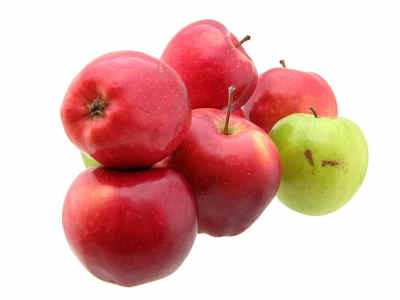Apple Tree A Good Food Provider?

Apple trees are domestic and with domestication invariably comes weakness and plants that need care. In a rebuilding society situation that might not be the ideal plant.
But let's not throw the apple tree out just yet. Do you have experience growing apple trees? If so then I would say without a doubt go for it.
There are many qualities that make apples a good choice but also apples come with a significant number of issues that could lead to failure. None of the obstacles are insurmountable, but the shear number of ways that you could fail lends me to say try another crop unless you have the room to try without needing it to be successful.
Potential obstacles
-Sun. Apple trees need lots of sun but not late-afternoon sun if that is possible. Northern or Eastern Slopes are preferred.
-Drainage. Apple trees should not be planted in area that don't have good drainage. If the area holds water after a rain then that is not a good location.
-Dwarf trees. Stay away from these as they have weaker root systems and more problems with wind and limb damage.
-Pollination. Apple trees can't pollinate themselves, so you need room for at least two trees. So now you see what I meant in the article opener. The trees need to be no more than 50 feet apart for good pollination.
-Pollination II. If you get two trees of different varieties be sure they bloom at the same time or you won't get any apples.
-Pollination III. Believe it or not a few apple varieties require two other pollinators. Stay away from these 'triploid' varieties.
-Pollination IV. Pear trees or any pome tree such as crabapple can be a pollinator for your apple tree just as long as they bloom at the right time.
-Soil. Good drainage. Other than that too rich or too poor can affect yield but isn't going to be a deal breaker.
-Fertilizer. Unlike most other trees don't fertilize your apple trees when they are young only when they are older. Backwards right!
-Thinning. Removal of some of the apples if you can lead to a bigger yield via bigger apples. The tree can only produce so much and apple trees can sometimes over produce. Obviously the first apples to thin will be the ones that show signs of damage.
-seed or sapling. You can certainly grow apple trees from seed but they will not likely produce a good apple. Possibly not even edible straight off the tree. You can increase your stand from seed and then graft onto the sapling from a good tree!
-Disease and pest. There are a number of disease and pest that hit apple trees. And in a SHTF situation you will not be able to run to the local nursery for modern remedies. Most of these issues will not kill the tree but you will loose all or part of your harvest periodically.
-Why? Why are you growing apples? Pick a variety for that purpose. Be it for raw apples, cooked apples or cider, there is a variety for that. Pick the appropriate one.
-Climate. Last but not least is climate. Apples trees require cold weather in the winter, called chill hours, in order to produce fruit. Pick a tree for your are. New varieties are being developed and you can now grow apples as far South as Arkansas.
So weigh your options and choose wisely. If you have the room, well you have nothing to lose. Give it a shot.
